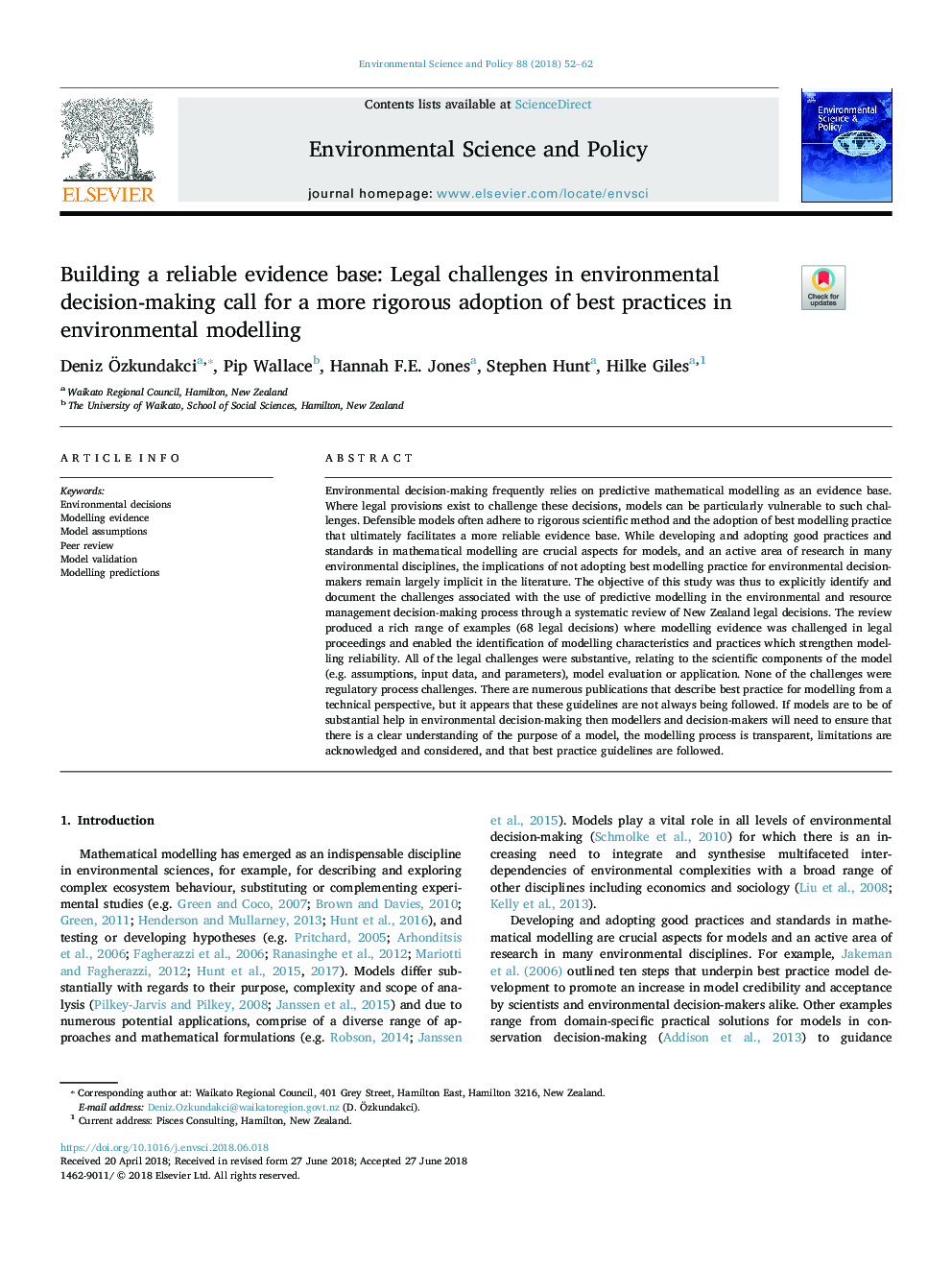| کد مقاله | کد نشریه | سال انتشار | مقاله انگلیسی | نسخه تمام متن |
|---|---|---|---|---|
| 7465759 | 1485020 | 2018 | 11 صفحه PDF | دانلود رایگان |
عنوان انگلیسی مقاله ISI
Building a reliable evidence base: Legal challenges in environmental decision-making call for a more rigorous adoption of best practices in environmental modelling
ترجمه فارسی عنوان
ایجاد یک پایگاه اطلاعاتی قابل اعتماد: چالش های قانونی در تصمیم گیری در محیط زیست موجب شده است که یک روش دقیق تر در زمینه مدل سازی محیط زیست مورد استفاده قرار گیرد
دانلود مقاله + سفارش ترجمه
دانلود مقاله ISI انگلیسی
رایگان برای ایرانیان
کلمات کلیدی
تصمیمات محیطی، شواهد مدل سازی، فرضیه مدل، بررسی دقیق، اعتبار مدل، پیش بینی مدل سازی،
ترجمه چکیده
تصمیم گیری در محیط زیست اغلب به مدل سازی پیش بینی ریاضی به عنوان پایگاه اطلاعاتی تکیه می کند. در مواردی که مقررات قانونی برای به چالش کشیدن این تصمیمات وجود دارد، مدل ها می توانند به طور خاص به چنین چالش هایی آسیب پذیر باشند. مدل های قابل دفاع اغلب به روش علمی دقیق و پذیرش بهترین روش مدل سازی پی می برند که در نهایت پایه مدارانه قابل اطمینان را تسهیل می کند. درحالیکه در حال توسعه و پذیرش شیوه های خوب و استانداردهای مدل سازی ریاضی جنبه های مهمی برای مدل ها و یک منطقه فعال تحقیق در بسیاری از رشته های محیطی است، پیامدهای عدم پذیرش بهترین روش مدل سازی برای تصمیم گیرندگان محیط زیست به طور عمده در ادبیات ضمنی وجود دارد. بنابراین هدف این مطالعه به صراحت شناسایی و مستند سازی چالش های مرتبط با استفاده از مدل سازی پیش بینی در فرایند تصمیم گیری در زمینه مدیریت محیط زیست و منابع از طریق بررسی منظم تصمیمات قانونی نیوزلند است. این بازبینی طیف وسیعی از نمونه ها را (68 تصمیم قانونی) به وجود آورد که در آن شواهد مدل سازی در مراحل قانونی به چالش کشیدند و شناسایی ویژگی ها و شیوه های مدل سازی را افزایش دادند که قابلیت اطمینان مدل سازی را تقویت می کنند. تمام چالش های قانونی مربوط به اجزای علمی مدل (مثلا فرضیه ها، داده های ورودی و پارامترها)، ارزیابی مدل یا برنامه کاربردی، بسیار حائز اهمیت است. هیچ یک از چالش ها چالش های فرایند نظارتی نبود. نشریات متعددی وجود دارد که بهترین شیوه برای مدل سازی را از دیدگاه فنی ارائه می دهند، اما به نظر می رسد که این دستورالعمل ها همیشه دنبال نمی شوند. اگر مدل ها از کمک های مهمی در تصمیم گیری در محیط زیست برخوردار باشند، مدیران و تصمیم گیران باید اطمینان حاصل کنند که درک درستی از هدف یک مدل وجود دارد، روند مدل سازی شفاف است، محدودیت ها تصدیق و در نظر گرفته می شود و این دستورالعمل های بهترین عمل پیگیری می شوند.
موضوعات مرتبط
مهندسی و علوم پایه
مهندسی انرژی
انرژی های تجدید پذیر، توسعه پایدار و محیط زیست
چکیده انگلیسی
Environmental decision-making frequently relies on predictive mathematical modelling as an evidence base. Where legal provisions exist to challenge these decisions, models can be particularly vulnerable to such challenges. Defensible models often adhere to rigorous scientific method and the adoption of best modelling practice that ultimately facilitates a more reliable evidence base. While developing and adopting good practices and standards in mathematical modelling are crucial aspects for models, and an active area of research in many environmental disciplines, the implications of not adopting best modelling practice for environmental decision-makers remain largely implicit in the literature. The objective of this study was thus to explicitly identify and document the challenges associated with the use of predictive modelling in the environmental and resource management decision-making process through a systematic review of New Zealand legal decisions. The review produced a rich range of examples (68 legal decisions) where modelling evidence was challenged in legal proceedings and enabled the identification of modelling characteristics and practices which strengthen modelling reliability. All of the legal challenges were substantive, relating to the scientific components of the model (e.g. assumptions, input data, and parameters), model evaluation or application. None of the challenges were regulatory process challenges. There are numerous publications that describe best practice for modelling from a technical perspective, but it appears that these guidelines are not always being followed. If models are to be of substantial help in environmental decision-making then modellers and decision-makers will need to ensure that there is a clear understanding of the purpose of a model, the modelling process is transparent, limitations are acknowledged and considered, and that best practice guidelines are followed.
ناشر
Database: Elsevier - ScienceDirect (ساینس دایرکت)
Journal: Environmental Science & Policy - Volume 88, October 2018, Pages 52-62
Journal: Environmental Science & Policy - Volume 88, October 2018, Pages 52-62
نویسندگان
Deniz Ãzkundakci, Pip Wallace, Hannah F.E. Jones, Stephen Hunt, Hilke Giles,
